|
Part 4 – sound & vision, special features and summary
All six films in this set have undergone restoration and all are in fine shape, though there is some small variation in quality due to the condition and availability of source materials. All six transfers are largely clean of dust dirt, while almost all instances of damage have been cleaned up. It's worth keeping in mind the age of the films and the fact that none of the restorations were from the original negatives, which by this point may well have been lost. The soundtracks are all Linear PCM 1.0 mono and have also been restored.
Morocco was scanned and restored in 2K from a 35mm safety finegrain preserved at the UCLA Film & Television Archive. It's the softest on fine detail of the films in this set, but the contrast is nicely graded, with solid blacks and n burned-out highlights. A few visible but short-lived scratches remain and there is a just-visible residue of wear and tear clean-up in places, but otherwise the image is clean and stable. There is some audible background fluff and hiss on the soundtrack and the dynamic range is narrow, hardly surprising when you consider that Hollywood was only in its third year of working with synchronised sound, but none of the dialogue is lost to these restrictions.
Dishonored has been scanned and restored in 4K from a 35mm nitrate print, which is also preserved at the UCLA Film & Television Archive. It exhibits beefier contrast than Morocco and its black levels are strong enough to shroud some shadow detail, but the film's expressive use of light and dark suggests this was intentional. Outside of the shadows the contrast range is nicely graded and particularly kind to facial close-ups, a von Sternberg strongpoint. Detail is rather good here, and while there is some slight variation on the sharpness, the best material is very pleasing, and there's little sign of damage or wear. The soundtrack is a little clearer than on Morocco and while there is still some audible background fluff, its level is low and on some silent scenes it's all but gone.
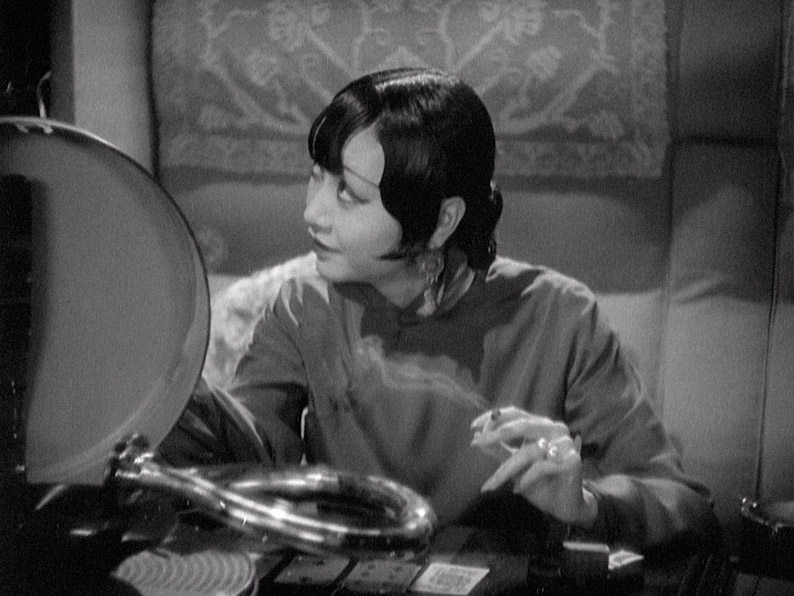
Shanghai Express was scanned and restored in 4K by Universal Pictures from a 35mm dupe negative and a composite finegrain and is generally in fine shape, with nicely-balanced contrast and solid black levels. There is some small variation in the sharpness depending on the shot or sequence, but on the best material the detail is crisp and distinct (a high-angle wide shot of the station before the train departs is a fine example). The cleaned-up wear-and-tear is occasionally just visible on darker shots, whilst others with large areas of black (the close-up of Lily praying) look fine. The soundtrack has the expected range restrictions and some minor background fluff, but the dialogue and effects are always clear.
Blonde Venus was scanned and restored in 4K from a 35mm nitrate print stored at the UCLA Film & Television Archive, which is increasingly sounding like a treasure house of preserved cinema classics. The contrast is punchy here, with inky black levels and little sign of any former wear, and while the sharpness of the fine detail can vary a little, at its best it's very good. For me, there's slightly less of a sparkle to the image than on the other transfers here, but given the film's grounding in a recognisable reality, this feels appropriate. The soundtrack exhibits the same restrictions as its comrades as well as the same strengths, with a narrowed dynamic range and minor background fluff but clear reproduction of the dialogue and effects, plus music that doesn't have an abrasive ring.
The UCLA Film & Television Archive also houses the 35mm nitrate print of The Scarlet Empress that was the source for 4K restoration used for this transfer, which displays a punchy contrast range with crisp blacks and good picture detail. The grain feels slightly coarser here than on the other five transfers in this set, but some of the facial close-ups look rather lovely. The range restrictions of the soundtrack are par for the course for a film of this vintage and do not muddy the dialogue or punish the music, and you'll have to really crank the volume to hear any background fluff on this one.
We know that The Devil Is a Woman was scanned and restored in 4K from a 35mm dupe negative, but the source for that one is not specified in the booklet. No matter, it still looks good, with robust contrast, a finer film grain than on The Scarlet Empress, and while the detail is not pin-sharp the image still flatters the set designs, costumes and lighting. The soundtrack here is free of background hiss or fluff and the dialogue is clear, with the inevitable range restrictions more evident in the music, which still sounds fine.
As you would expect, optional English subtitles for the hearing impaired are available for all six films.
MOROCCO
Audio Commentary with Samm Deighan and Kat Ellinger
Another hugely educational and enjoyable commentary from Daughters of Darkness Samm Deighan and Kat Ellinger, one that's rich with insightful opinion and information on the making of the film and those involved in its production. There is, unsurprisingly, a particular focus on Dietrich that includes details of her arrival in America, her work with wartime refugees, her colourful life in Berlin, her work with von Sternberg, and more. Both women discuss the specific appeal of pre-Code American cinema, the portrayal of women in von Sternberg films, the texturing that ensures that Morocco rewards repeat viewings, the director's use of sound and silence... I could go on. A damned fine companion to the film.
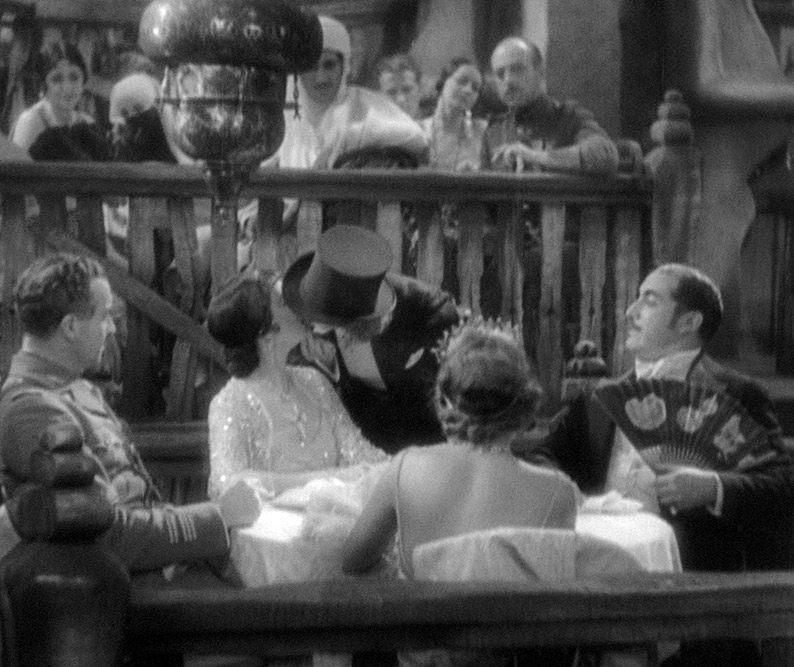
Introduction by Nicholas von Sternberg (10:36)
Josef von Sternberg's son Nicholas provides a useful overview of his father's early film work and his discovery of Dietrich and the fight he had to cast her in The Blue Angel, before moving on to talking specifically about Morocco. The story told elsewhere that von Sternberg did 90-plus takes of Dietrich's first line to get it right is repeated here, as is the rumour that Dietrich was instrumental in designing her own costumes. An engaging piece.
The Art of Josef von Sternberg (9:22)
Here Nicholas von Sternberg talks about his father's drawing, painting and sculpture work, much of which is shown in a continual slideshow of the work in question. He also talks about his own childhood, how his father taught himself to paint and sculpt, and suggests that when it came to filmmaking, he just didn't like colour (he only directed one colour film in his career).
Lux Radio Theatre: The Legionnaire and the Lady (59:22)
This audio version of Morocco, produced for Lux Radio Theatre in 1936 with Marlene Dietrich reprising her role and Clark Gable substituting for Gary Cooper, is interesting for a number of reasons. As ever, it's amusing to discover how a visually told story that runs for 92 minutes could be compressed into less than half its original running time and get by without its imagery. Well, it does and it doesn't. What gives this adaptation specific historical value is that, unlike the film, it was made after the Production Code had come into effect, and despite not being a motion picture it would have been similarly constrained by its rules. There is thus no talk of infidelities with Adjutant Caesar's wife, and when Tom is facing a possible court martial here it's for insubordination, not for defending himself when attacked by two assassins hired by his spurned lover. There's plenty of this moral whitewashing on show here, including the decision to give Caesar a sinister past to cast him as a more easily punishable bad guy. As Tom, Gable is as sprightly as ever, but there's a sense that Dietrich was less enthusiastic at the prospect of a high-speed rerun of a role she perfected six years earlier, and perhaps as a result she delivers many of her lines in weary monotone. The visual poetry of von Sternberg's direction is obviously lost and elements that were subtly handled in the film are banged home here, and the exquisite timing of the dialogue delivery of the film is often completely lost. A sizeable chunk of the running time is given over to guest presented Cecil B. DeMille for superficial chats with colleagues about their work or to embarrassingly plug Lux soap products, though Dietrich fans would do well to stay with it for her performance of Falling in Love Again, the song with which she is still most commonly associated.
Image Gallery
62 pages of production and promotional photos – many of which are of excellent quality – garishly coloured front-of-house stills, press material and posters.
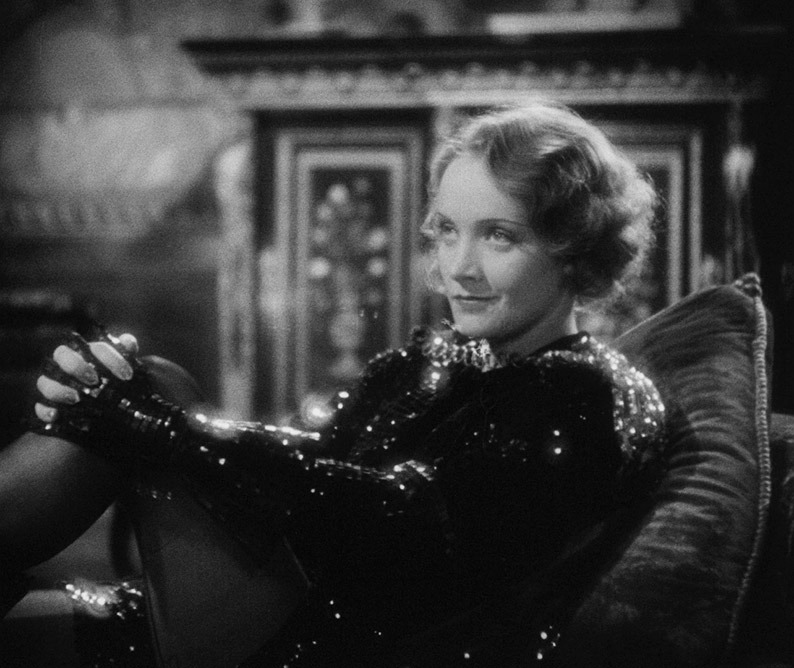
DISHONORED
Introduction by Nicholas von Sternberg (11:28)
Josef von Sternberg's son states up front that Dishonored was intended as an anti-war statement, and links that to the experiences of his father and his uncle during the First World War. He notes that von Sternberg was in the Signals Corps with Henry Hathaway, Lewis Milestone and Victor Fleming, all of whom also went on to have successful Hollywood careers, and also talks about his father's post-war career and his working relationship with Marlene Dietrich.
Josef von Sternberg: A Retrospective (77:29)
A feature-length documentary by Belgian director Harry Kümel that kicks off with a useful overview of von Sternberg's film career, but the meat of the piece comes in the shape of an interview with the 75-year-old von Sternberg and footage of him arranging the lighting to film a facial close-up of actress Dorothée Blank. The film has a sometimes broken mirror structure, with snippets of the interview and von Sternberg's arrival on set blended into the biographical material and footage of him at an art gallery commenting on the work of painter Antoine Wiertz ("The man is a genius and if he knew a little bit more he'd have talent"). The footage of von Sternberg, whether directing or in interview, is of immense value and is peppered with memorable quotes from him about the filmmaking process, describing himself as "an accidental director" and actors as marionettes who "do what a director tells them to, nothing else." I have a feeling he and Hitchcock would have got on like a house on fire.
I Did What He Told Me to Do (16:46)
A new video essay by film historian Tag Gallagher that explores the working relationship between Josef von Sternberg and Marlene Dietrich. As ever with Gallagher, there are interesting observations in here, particularly about the different personalities Dietrich displays in Dishonored and the way she uses expressions and body movements to communicate emotion and intention, something that also struck me in these films. Gallagher does discuss each of the films in this set, complete with potentially plot-spoiling extracts, so I'd save this one until after you've seen all of the films.
Image Gallery
17 pages of promotional imagery (including some of the most violently coloured front-of-house stills I've ever seen) and posters, four of which have the film titled as ‘X-27'.
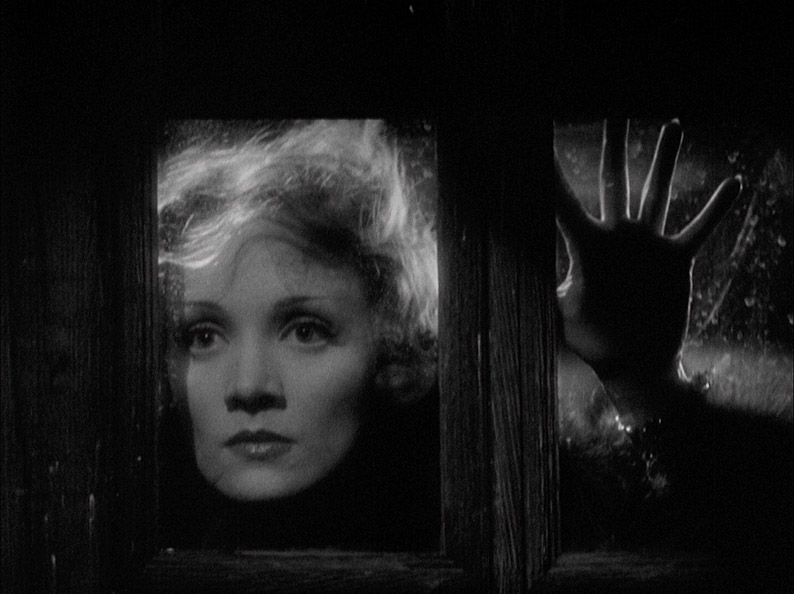
SHANGHAI EXPRESS
Audio Commentary with David Thompson
Writer, occasional critic and maker of arts documentaries (including one for the BBC in 1994 on Josef von Sternberg) David Thompson provides an engaging analysis of the film and those involved in its making. He amusingly sums up the film's portrayal of China as "rather like entering a kitsch Chinese restaurant," but does a sterling job of deconstructing the meaning behind specific sequences and elements, including the film's use of frames within frames, the use of long dissolves and the filling of what is known as negative space. There's info on the actors, cinematographer Lee Garmes and, unsurprisingly, von Sternberg, about whom Thompson delivers a few surprising titbits, including the claim that he influenced the music of The Doors – you'll need to listen to this to understand why. He also discusses a jarring jump-cut in the film that I'd noted as a possible restoration issue and confirms that the absent frames have always been missing and that nobody has been able to clarify why.
Introduction by Nicholas von Sternberg (4:04)
A brief introduction to the film from von Sternberg's son, who praises the sets, the story and the use of frames within frames, and again suggests that Marlene Dietrich had a hand in the design of her costumes, which really are something here.
Trouble in Hollywood (24:08)
Jasper Sharp, writer, curator and co-editor of the Midnight Eye website, looks at the life and career of Anna May Wong, providing details on her background, her early roles, her breakthrough films, her later work and her eventual abandonment of Hollywood due to the restrictive nature of the roles she was offered. There are a few surprises here for those not well versed in Wong's career, not least the news that she made her London West End stage debut playing opposite Laurence Olivier and that she later toured the UK with a one-woman variety show. An informative and interesting extra.
Image Gallery
40 slides of promotional imagery, including posters, photos and coloured-in front-of-house stills.
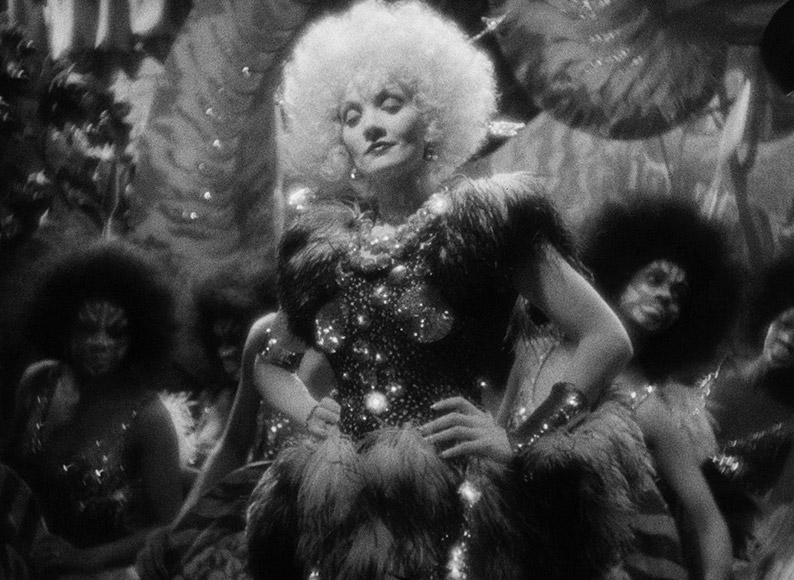
BLONDE VENUS
Audio Commentary by Adrian Martin
Australian film scholar and critic Adrian Martin provides a typically in-depth look at the film, exploring its themes, its subtext, its style and its characters, as well as looking at what makes it a specifically Josef von Sternberg film. His comments are always interesting and intermittently fascinating, whether it be the news that the surrealists adored von Sternberg's work or his suggestion that the film is a fantasy into which the outside reality of the Great Depression has made its way. We get information on the three different versions of the script and details of how the censorship process of 30s Hollywood functioned. There's a lot more here, all of it worthy of your attention.
Introduction by Nicholas von Sternberg (6:35)
Nicholas von Sternberg offers a slight repost to Adrian Martin's description of Blonde Venus as "strange and surreal" by stating up front that the film is a lot of fun, which I have to admit would not be the first words that sprang to mind if I were asked to briefly summarise it. He confirms that his father carefully controlled the lighting in his films and backs up a story told elsewhere that von Sternberg advised Cary Grant to switch the side on which he parted his hair and that this became his signature look from that point on.
Dietrich, a Queer Icon (24:38)
Author So Mayer explores Marlene Dietrich's impact on the portrayal of gender in film and why she was considered a gay icon, opening with the tautological observation, "If you don't get it, you don't get it." She discusses Dietrich's onscreen image, how she questions and parodies male authority, and cannily notes that the men in her films fall in love with the characters she plays even though they know they shouldn't. There are serious spoilers for Dishonored here, so watch that film before dipping into this.
Image Gallery
43 pages of promotional stills, posters, press material and, most intriguingly, design drawings for some of Dietrich's costumes.
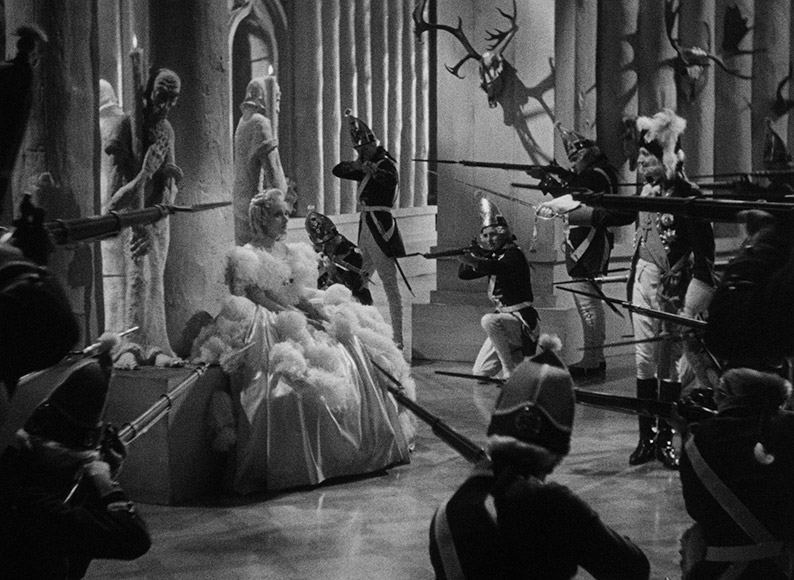
THE SCARLET EMPRESS
Audio Commentary with Tony Rayns
As soon as I saw the name of writer and Asian cinema guru Tony Rayns on the special features menu I knew this would be a commentary to savour and I wasn't wrong. As ever, Rayns is not interested in simply commenting on what is happening on screen and instead gets under the skin of what he admits up front was one of the films that got him interested in cinema in the first place. We get a list of some of those who worked the film but were not credited, specifics on the film's many deviations from historical fact, information on the score, the script development, cinematographer Bert Glennon and sculptor Peter Ballbusch, and possibly the most detailed biography of von Sternberg yet in this collection. Rayns comments on the characters and the mirroring of sequences, explores the film's grammar and specifically von Sternberg's use of dissolves and montages, and he prompted me to slap my forehead in one of those "of course!" moments with his suggestion that Sam Jaffe's portrayal of Peter was modelled on Harpo Marx. There's so much more here. A riveting and hugely informative commentary.
Introduction by Nicholas von Sternberg (6:46)
Here Nicholas von Sternberg talks about his father going all-out on the sets, composing some of the music and taking control of the lighting, to which end he apparently kicked almost everyone – cameraman included – off the set. He comments on the work of sculptor Peter Bullbusch and intriguingly states that his father wasn't interested in realism, only the illusion of realism.
Josef von Sternberg: An Introduction (74:56)
An audio recording of an onstage talk about von Sternberg by his biographer John Baxter (who also authored An Appalling Talent,my favourite book on the cinema of Ken Russell), recorded at London's BFI Southbank on 1 December 2009 and running under the film as a second commentary track. There's a delightful – and, I'm tempted to say, very Australian – honesty to Baxter's appraisal, admitting up front that Shanghai Express is one of his favourite films even though the plot is "piffle" and describing von Sternberg on their first meeting as "intolerable." There is some discussion about screened footage that we (obviously) are unable to see, but for the most part this is enthralling stuff, bolstered by Baxter's detailed knowledge of and enthusiasm for his subject. Particularly pleasing is that much of what he has to tell us is unique to this extra, with considerable detail provided on the personal relationship between von Sternberg and Marlene Dietrich and how this was reflected in their films (particularly Blonde Venus). He also takes the BBC documentary on von Sternberg's abortive attempt to make a film of Robert Graves' I Claudius to task for its inaccuracies, provides plenty of information on the director's 1953 Japanese wartime drama The Saga of Anatahan, and even shares a few details from Marlene Dietrich's FBI file. Great stuff.
The Twilight of an Angel (54:03)
A documentary by French filmmaker Dominique Leeb that explores Marlene Dietrich's final years, which were spent primarily in bed in her small Parisian apartment. Those interviewed include her close friend Louis Bozon, her biographer Gilles Plazy, her neighbour Elaine Ladouble, her daughter Maria and her grandson Peter. Often interesting and perhaps a little sad, it includes footage of her apartment, which appears to have been preserved almost as a shrine, and recordings of some of the many phone messages she left for Bozon, including one asking him what her own phone number was.
Image Gallery
48 screens of promotional and press material, including a good selection of international posters.
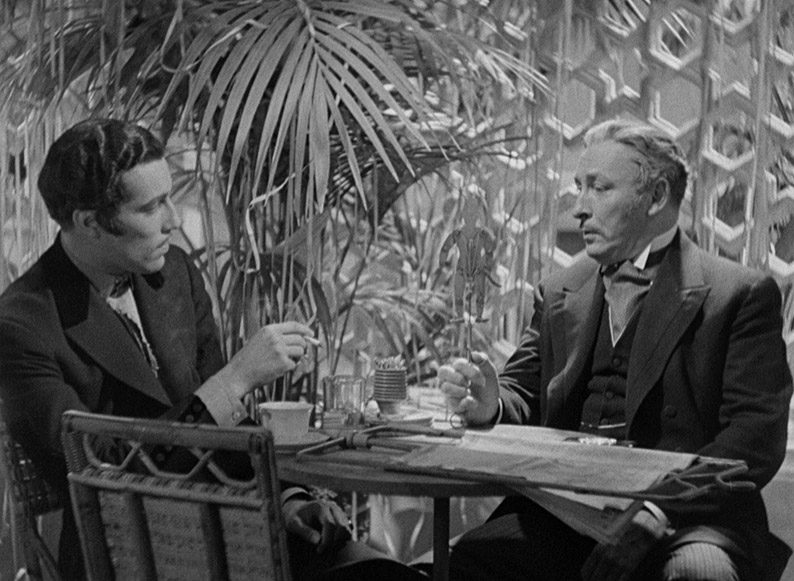
THE DEVIL IS A WOMAN
Introduction by Nicholas von Sternberg (8:27)
Nicholas von Sternberg begins his final introduction in this set by revealing that once shooting on The Devil is a Woman was complete, his father walked off the set and turned his back on everyone, Dietrich included, effectively bringing this chapter of his life and career to an end. He talks about aspects of the film's style and an objection to the film lodged by the Spanish government that apparently saw the original negative and most of the prints destroyed. I've yet to find confirmation on this one, but if anyone should know I guess it would be the director's son.
The Fashion Side of Hollywood (10:24)
A from-the-time studio short in which Kathleen Howard, a former fashion editor at Harper's Bazaar, talks to Paramount costume designer Travis Benton about his creations, particularly those done for Marlene Dietrich on The Devil is a Woman. Howard comes across as a judgemental English matron who has found something to gush at – "she's simply marvellous, Travis," she says of Dietrich at one point – and how much you'll get out of this extra will depend on your tolerance for our Kathleen and how interested you are in fashion. I have to confess that my attention wandered a tad.
Styling the Stars (22:42)
Having not been enthralled by the previous featurette, the prospect of spending twice as long listening to someone talk about Travis Banton's costume designs did not exactly thrill me. To my surprise, Nathalie Morris easily held may attention by not just discussing the costumes Marlene Dietrich wore in her six Hollywood films for Josef von Sternberg in terms of their design, but by also exploring their subtextual messaging and how they help define the characters she played. We also get biographical information on Banton and his working relationship and long-term friendship with Dietrich. Good one.
If It Isn't Pain (Then It Isn't Love) (2:52)
Unlike the previous films in this set, The Devil is a Woman did fall foul of the Hays Code restrictions and some sequences were forcibly removed. The footage itself has been lost but this audio recording of Marlene Dietrich singing the above-titled song – one whose faint whiff of sadomasochism may well have contributed to its removal – has survived. The quality is far from perfect, but it's still a valuable grab, and full marks to Indicator for including an optional English subtitle track for the hearing impaired and anyone who struggles with the audio quality.
Image Gallery
26 pages of promotional stills and posters.
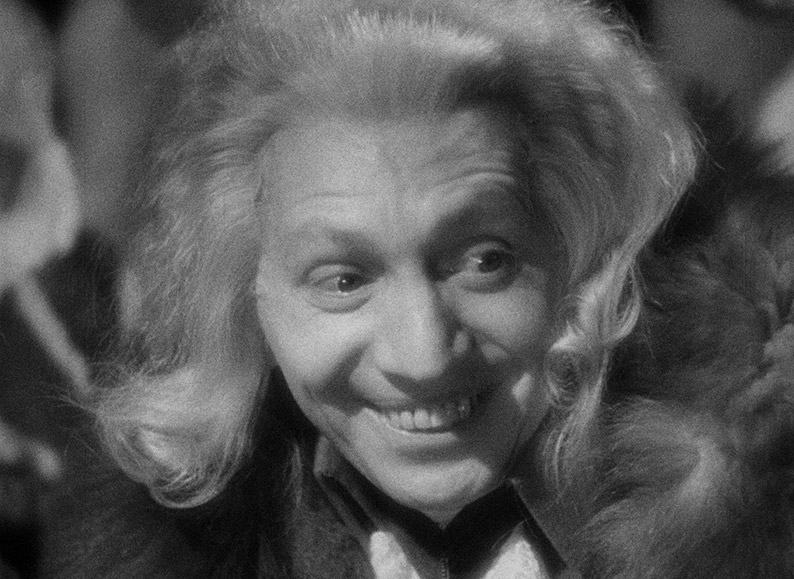
ALSO
Booklet
Finally, we have a glorious 118-page booklet that is crammed with information on the films, the filmmakers and the performers. It opens with full credits for all six of the films and closes with details on the restorations and transfers, as well as credits for this Blu-ray release, which I read in order to properly salute those responsible. The opening essay is a sizeable contribution by freelance writer and film historian, Pamela Hutchinson, which provides an enthralling overview of Dietrich and von Sternberg's Hollywood adventures and explores the six films in this set in educational detail. There's some lovely stuff here, notably when Hutchinson describes The Scarlet Empress as "film so sensuous and debauched, so ironic and macabre, so simultaneously elegant and grotesque, one suspects that von Sternberg was working for the thrill alone." Lovely. Next we have some welcome extracts from von Sternberg's intriguingly titled autobiography, Fun in a Chinese Laundry, in which he talks about his Hollywood collaborations with Dietrich, whom he recalls with genuine fondness and admiration for her skills. After this there is a 1931 article from the Los Angeles Times on Dietrich's rise to stardom, which is followed by a short but peculiar piece from the San Francisco Examiner, published the same year, in which Dietrich is asked whether she and her husband like German desserts. Apfelstrudel, anyone? There's an extract from Dietrich's autobiography in which she writes about letters she received in 1932 that took the form of threats to kidnap her 7-year-old daughter Maria unless a ransom was paid, a tangible prospect when you consider that the infant son of famed aviator Charles Lindbergh had been kidnapped and ransomed earlier the same year. We are then teased with artwork and explanatory text for two ultimately unrealised collaborations between Dietrich and von Sternberg titled Hurricane and Deep Night, both of which I'd watch on the basis of the titles alone. Next there is a reproduction of a 1936 article by columnist Lawrence Laybourne about Dietrich and von Sternberg that is littered with studio publicist-invented inaccuracies about their respective backgrounds, plus a 1935 piece by gossip columnist Mollie Merrick that is tiresomely judgemental about the image of Hollywood stars and particularly their weight, with a footnote extract from Dietrich's autobiography in which she reflects on the pressure to always look slim. Bringing up the rear, we have some choice extracts from contemporary reviews of the six films in this set – the two-sentence Monthly Film Bulletin dismissal of The Scarlet Empress is a bit galling, though the then-new journal was considerably kinder to The Devil is a Woman. There are also some later reappraisals of the films from the likes of Andrew Sarris, Robin Wood and Cahiers du cinema.
Despite technically having more free time now than I've had in some years, my life has continued to attract complications that play merry hell with my ability to deliver reviews by the release date of the disc in question, but circumstances really were against me on this one. It's one thing being unable to start work on a disc review until the release date, but quite another when that disc is a six-disc box set of films with which you are criminally unfamiliar and accompanied by an Indicator-sized collection of special features. As I said at the start of this gargantuan review, my original intention was to keep the coverage of the films themselves brief in order to speed up the process of getting it uploaded, but I just couldn't do it. In almost every box set I've covered there is at least one film that leaves me a little nonplussed and the overall quality is (almost) inevitably uneven, but all six films in this extraordinary, gorgeously presented set just blew me away. Yes, I felt like an arse for not having seen most of them before and for not re-watching the two I hadn't seen for so long, but that only served to increase the level of pleasure I experienced at what felt like discovering all six for the first time. These films are also so textured, so layered with subtext and so visually complex that repeat viewings are almost mandatory if you're going to get the most out of them. As ever, Indicator has sourced the best available restorations for the transfers and have littered the set with some excellent special features, including four terrific commentaries, a belter of a booklet and some fine archive material. There's no question in my mind that this is a hot candidate for my favourite Blu-ray box set of the year so far. I loved everything about it and it thus gets our highest recommendation.
|